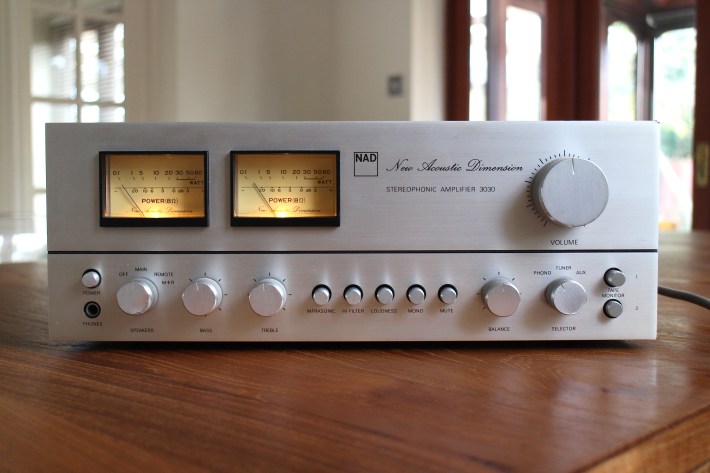
Meet one of New Acoustic Dimension’s lost gems, the integrated amplifier that came before the product for which the company is most famous by far – the NAD 3020. Actually, in hi-fi terms, it’s not the barnstormer that its successor was, but it’s still an interesting piece that, without which, NAD would never have become the brand that it was. Think of it as the ‘gateway drug’ to the 3020!
Launched in 1976, it was par for the course as mid-nineteen seventies amplifiers go. It cost £89 in the UK, which made it a ‘premium budget’ design – a step up from the 3020 which arrived three years later and initially sold for £59. On the face of it, the 3030 is better built than its successor, being the last generation of NADs until recently to sport a brushed aluminium fascia and knobs. This feels as good as any Sony, Pioneer or JVC of the day, and was available in a choice of black or silver. In addition to its generous range of facilities – including twin tape monitors, speaker A&B switching and high and low filters – it sported twin, large power meters. These were de rigeur for that period but pretty useless, because the ballistics of the needles were too slow to be meaningful. In truth, they were more about showroom appeal.
What was more substantive was the innards – the 3030 (as its name suggested, according to NAD nomenclature of the day) delivered 30W RMS per channel. Although nothing now, it was a fair old whack of power in 1976, when most rivals such as the JVC JA-S11G struggled to top 25W. Like computer RAM memory size, these tiny differences in numbers seemed far more important back in the day. The amp used a conventional frame-type transformer, carried over to the 3020, and was quite complex by the standards of the day. A look under the hood reveals miles of wiring – hardly the stripped down minimalism of its successor.
Speaking of which, the 3020 took much of the 3030’s design approach, laid it out better inside, taking out the clutter in the process. Those twin analogue meters became one, five-segment LED display, for example. The 3020 also got a clever stepped rear panel, making it easier to plug things in, and separate pre-power socketry, plus NAD’s clever soft clipping. Basically, all the mess of the 3030 was taken away and in its place lots of genuinely useful features for audiophiles were added. The 3020 was of course down on power (20W RMS into 8 ohms, quoted) but had a stiff power supply, like the 3030.
Sonically, you can certainly hear the family resemblance. The 3030 is a big hearted and warm sounding performer with plenty of power (for its era) and a muscular, solid sound. Its bass is slightly fulsome, its treble sweet and the midband is smooth, wide and a little diffuse and fluffy sounding. The 3030 is a pretty pleasant thing to listen to, given its price and age but frankly is no 3020. Its successor has a substantially more propulsive and musically committed sound, with a little less power but a bit more torque.
Overall then, the NAD 3030 is an interesting old integrated amplifier that all NAD collectors should have. It’s still in reasonably plentiful supply, with decent examples appearing for £150, while you should pay half that for a tatty one or twice that for a boxed, minter. If you’re into retro audio and/or have a second system that could do with a flexible, decent sounding integrated, this is well worth a try.

En 1979 est sorti le 3045, 2x45W, que la Revue du Son estimait “neutre et propre, très dynamique” dans son numéro d’Octobre 79 (2x58W au banc!). C’est lui que j’ai acheté en 1980, après écoute du 3030, des Harman-Kardon 401, Marantz 1060, Yamaha 410, et un Luxman de prix approchant. Le 3045 n’avait aucun des défauts de ses concurrents !! Il marche toujours, mais depuis 3 ou 4 ans le canal droit a progressivement diminué de volume, jusqu’à ne plus pouvoir maintenant équilibrer avec la “balance”… Je serais heureux de le restaurer car avec lui je ne me suis jamais posé de question, sur kit SEAS, puis Triangle, B&W, et autres DIY de rencontre!